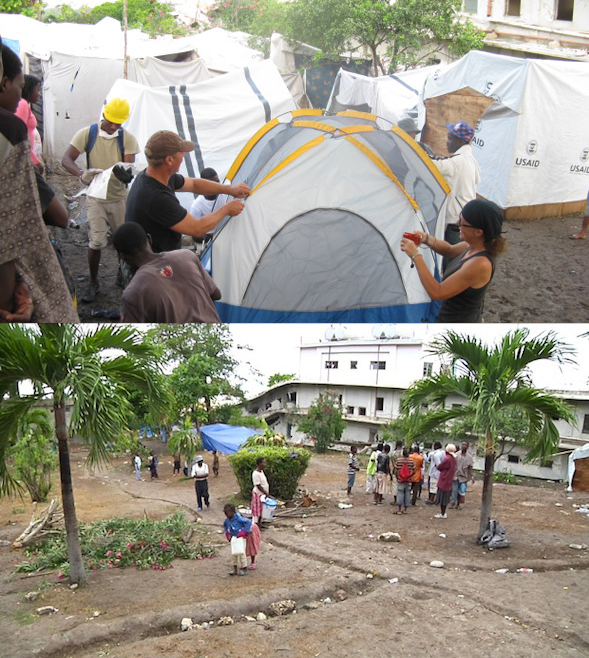Haut-Turgeau, Haiti: The Camp That Vanished and the Priest Who Forced Them Out
 Print This Print This
By Ansel Herz
Media Hacker
Wednesday, Mar 10, 2010
Perched near the top of a steep hill, the
fractured pink walls of Villa Manrese overlook the rest of the capital
city. Both ends of the three-story compound have collapsed, spilling
into mounds of rubble. The first floor was pulverised into a layer of
dust. There are still bodies inside.
But in the adjacent
garden behind the Catholic retreat, also known as Centre Saint-Viateur,
life sprang anew after the Jan. 12 earthquake struck Haiti.
Some 250 families, comprising 1,500 people from the
surrounding area of Haut-Turgeau, crowded together in the small field.
Father Paul André Garraud, a Haitian priest based in the villa, helped
procure tents, food, and medicine from relief agencies.
"We were doing well because they organised us. We weren't
hungry," said Lubin Pierre-Louis, 52, leaning on a cane in the middle
of the empty field. Three boys play soccer with a dirty plastic bottle
on the wet ground behind him.
The camp vanished overnight on Mar. 2.
 |
| First photo by Jane Elizabeth Avenell-Guardigli, second from me. Before March 2, and after. The dirt is still lined with trenches, made by camp-dwellers to divert the rains. |
|
"It's wrong. They told us to leave in the middle of the night,"
Pierre-Louis said. "Just staying here now is a resistance. If they ask
me to leave, I'll be forced out."
Residents who formed the informal committee running the tent
camp swept through at 11 p.m., according to witnesses, telling everyone
they had to leave immediately.
Families were told that bulldozers would come onto the field
early in the morning to demolish Villa Manrese. No demolition crew
arrived and the villa is still standing.
"They told us the bulldozer was coming to intimidate us," said
Johnny Cherezard, a 23-year-old student. "The government said nobody
has a right to push people out unless they have a place to go. We had
people who were sick and injured."
"The Father gave the signal to the committee to force people out," he said. By 3 a.m., most people had left the camp.
Father Garraud is living in a neighbour's gated home 40 yards
away from the camp. In an extended interview next to the pool, he
blamed the removal of the people from the area on the camp's committee
members.
"The committee was organising so badly. I told them one month
in advance to prepare places because they're going to have to move for
the demolition," he said. "They didn't do anything."
Garraud said he slept through the night and was surprised
Wednesday morning to see the empty field. He claims the committee acted
on its own.
Four of the committee members, sitting on the steps of a
nearby building together, insist the priest told them that night to
move everyone out because the villa would be leveled in the morning.
"The priest has to protect himself, that's why he blames it on
us," said Damis Duviose, a heavy-set young man. "We lived in the camp
too, now we're just down the road. We didn't make the decision, we
can't do anything without the priest saying so."
Jane Elizabeth Avenell-Guardigli is a British woman living in
the Dominican Republic. With some friends, she brought supplies over
the border after the earthquake and wound up staying at the same house
as Father Garraud.
"We were awoken in the night," she said in an interview.
"There was lots of screaming and people calling for Pѐre Garraud. He
was up and listening, but he did not go to see them."
"We stayed up all night listening to the screaming. They all
had to go back to their streets, by the ruins of their homes,"
Avenell-Guardigli said.
"There's no way I can imagine justifying their actions," she added.
At least one Canadian body, along with the body of a French
national, still lie beneath the rubble. Haitians call the area around
Villa Manrese "Impasse Canada" because so many Canadians came to stay
there.
Five staff from the Canadian embassy came to the site to talk
with Father Garraud. The embassy asked the Haitian construction company
Vorbe Et Fils for an estimate on removing the body, but gave the
contract to the state construction company CNE.
The priest said CNE told him several times last week they were
coming to begin the operation, but they never came. The French embassy
asked the Canadians to pull out the French body as well in the
operation.
The camp committee members believe Father Garraud was
pressured into moving ahead with demolition by construction companies
and the Canadian embassy. Garraud denied being pressured by anyone.
The Canadian embassy did not respond to requests for comment by publication time.
Around a dozen men, women, and children still occupy the field.
Leonardo Delzor, 11, lost his aunt, uncle, and father in the
earthquake. "I came to sleep here sometimes," he said Saturday. "But
last night when it was raining, I slept standing up. I had to hide my
body in a little corner. "
"I want somebody to help me, even if he only gave me a tarp,
because I could spread it out to sleep on it," he said. His blue shirt
is smudged with brown mud.
"They moved people out that night, but I stayed here because I have nowhere to go," Delzor said.
Media Hacker
 Print This Print This

|

